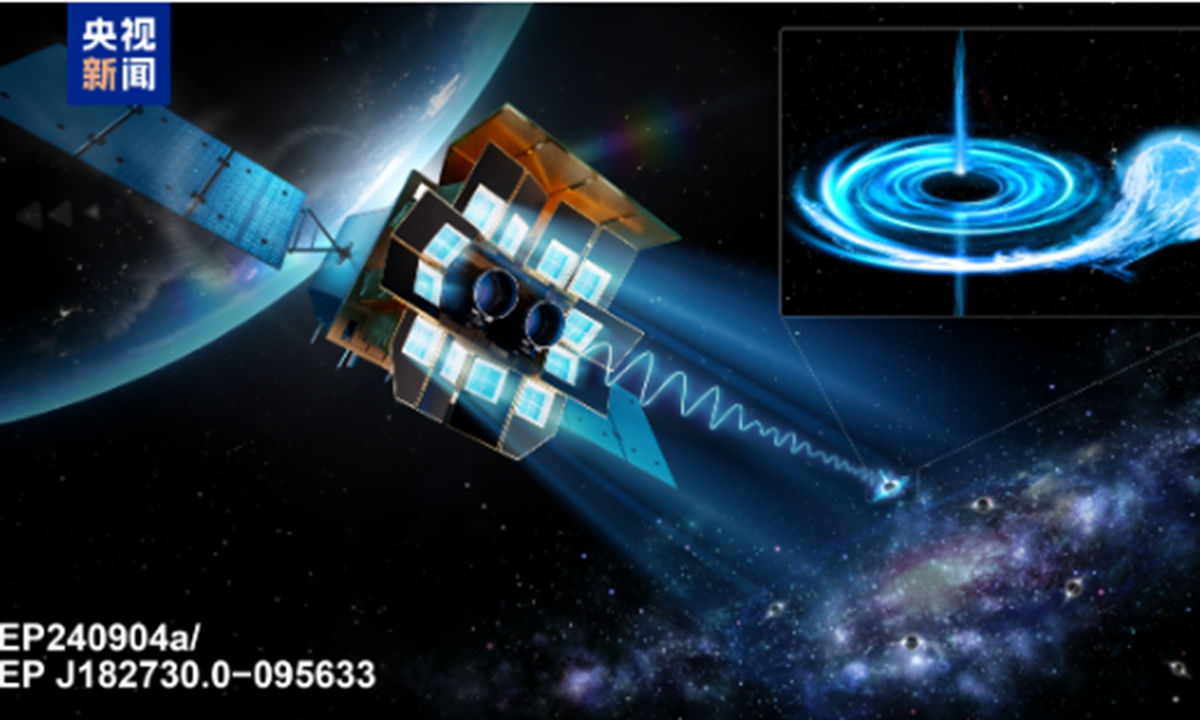
The "Tianguan" satellite detects the faint X-ray burst EP240904a in the Milky Way. Photo: Screenshot from CCTV News
During the 15th Five-Year Plan period (2026-30), the National Space Science Center of the Chinese Academy of Sciences (CAS) will launch a series of scientific satellite missions. These missions will focus on major frontiers such as the origins of the universe, the origin of space weather, and the start of life, officials said at a press conference held on Monday about the latest achievements of China's space science pilot program.
Key missions include the "Hongmeng Program," the Kuafu-2 satellite, and mission to search for Earth-like planets outside our solar system, as well as an upgraded X-ray timing and polarization space observatory. Scientists aim to make new breakthroughs in areas such as the "cosmic dark age," the sun's magnetic cycle, and finding Earth-like exoplanets, officials said, according to China Central Television (CCTV).
Per a CCTV report, the Hongmeng Program, designed to listen to the "infant cries" of the universe, comprises 10 satellites forming a low-frequency radio telescope array. They will collectively travel to the far side of the moon — a quiet "radio room" in the cosmos that shields all noise from Earth and the sun, enabling the capture of faint signals from the depths of space. It will help unlock mysteries from the chaotic hundreds of millions of years after the Big Bang, before the birth of the first stars.
The Kuafu-2, which "stares directly at the sun," will be the first in the world to orbit above the sun's polar regions, acting as a high-altitude photographer gazing directly at the sun's "North Pole" and "South Pole." These areas hold key secrets of solar magnetic activity.
The third satellite is an exoplanet survey satellite "searching for a new home for humanity." It will scan the galaxy for "Earth 2.0" — planets roughly Earth-sized and located in the habitable zone. According to the CCTV report, it may one day point us toward a long-awaited second home for humanity.
The fourth satellite is a "space observatory" operating beyond Earth's atmosphere, tasked with observing "extreme forbidden zones" in the universe, such as the event horizon of black holes and the scorching surfaces of neutron stars, where gravity can tear the fabric of spacetime and magnetic fields reach strengths a trillion times greater than Earth's.
At the conference, the CAS National Space Science Center also presented major scientific progress from its existing satellites. These include discoveries related to transient cosmic objects, cosmic-ray propagation, and solar eruptions.
Since its launch in 2011, China's space science pilot program has successfully launched eight scientific satellites. Notable examples include Wukong (Dark Matter Particle Explorer), Shijian-10, Micius Satellite for quantum science experiments, Insight hard X-ray modulation telescope, Taiji-1, Huairou-1, Kuafu-1, and Tianguan - China's Einstein Probe astronomical satellite, per the report.
These satellites have produced many original discoveries—some are China's firsts, and even world firsts. As China's first program to support space science systematically, it has pushed China's space research from "following others" to "keeping pace" and even "leading" in some fields. Today, Chinese space scientists are playing a bigger role on the global stage, officials said at the press conference.
Over the past 15 years, the program has shown a clear focus on expanding and deepening research in four "extreme" directions. In extreme macrocosm, China produced the world's first all-sky X-ray map; in extreme microcosm, Chinese researchers obtained the most precise spectra of cosmic ray electrons, protons, helium nuclei, and boron nuclei to date.
Under extreme conditions, scientists measured the universe's strongest magnetic field directly for the first time, and detected high-speed jets closest to black holes; extreme interdisciplinary integration was also achieved by the close integration of science, technology, and engineering development.
Meanwhile, the program has also actively pursued comprehensive, multi-level international cooperation, pioneering new models of global partnership, according to officials from the National Space Science Center.
For example, the SMILE satellite is the first full-mission, whole-cycle deep cooperation between CAS and the European Space Agency (ESA); the Tianguan satellite led by China, with participation from ESA, Germany, and France, marks ESA's first involvement in a Chinese space science mission as an "opportunity mission."
By establishing international scientific teams and promoting data sharing, China continues to enhance the global influence and effectiveness of its scientific satellites, the center said.
















